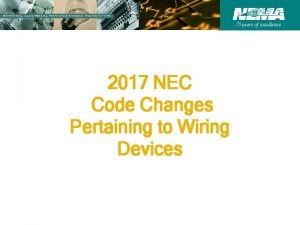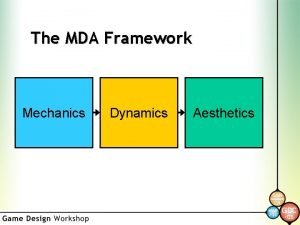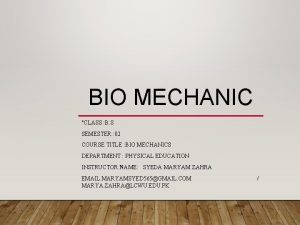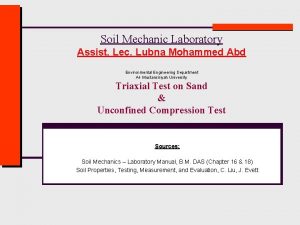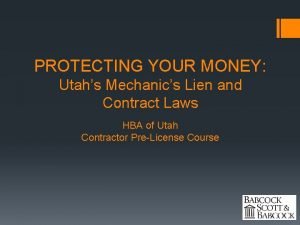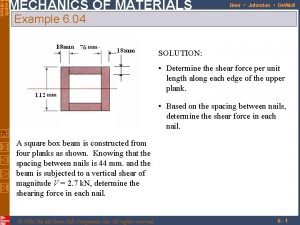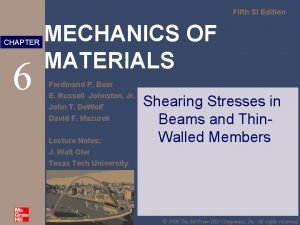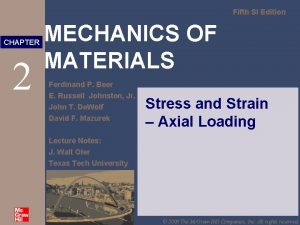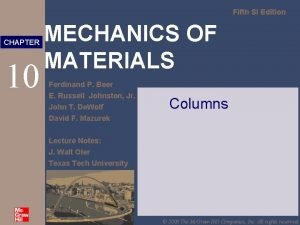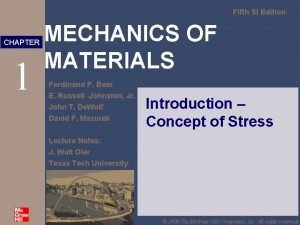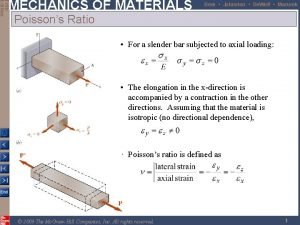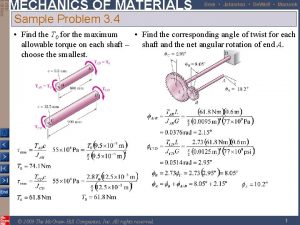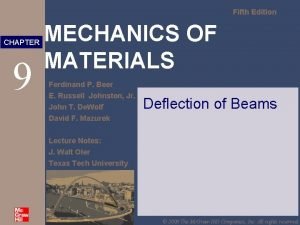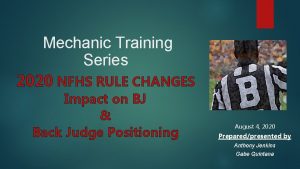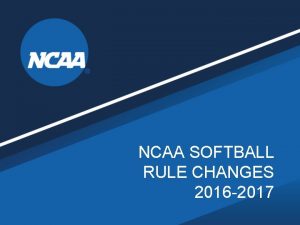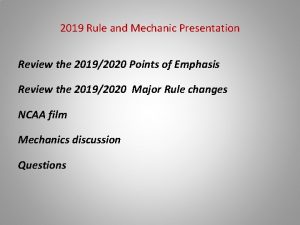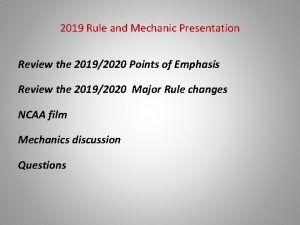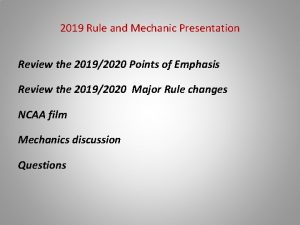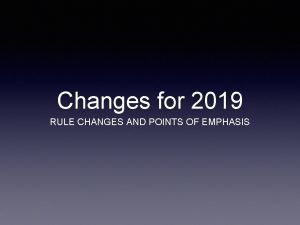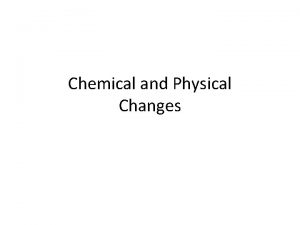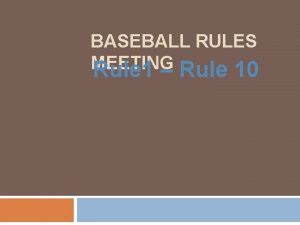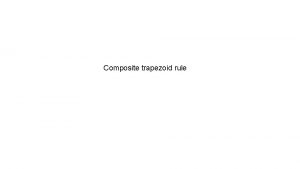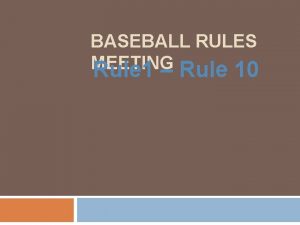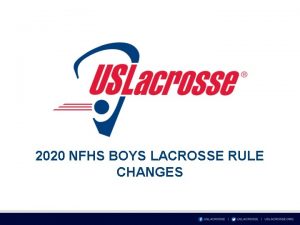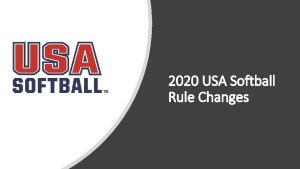2017 Rule and Mechanic Presentation Rule Changes Very



























- Slides: 27

2017 Rule and Mechanic Presentation • Rule Changes – Very few rule changes for the most part just clarifications • Review of MAJOR rule changes – Sixteen major changes were instituted – They are outlined on page 6 of 2017 -2018 Rulebook

2017 Rule and Mechanic Presentation • Rules related to the Crosse – Pocket • Rule 1 -18 now states the side walls must be completely attached leaving no gaps large enough for the ball to pass through. – Mesh • Rule 1 -19 A. R. 17 now states the mesh weaving of the crosse may be of more than one color. – Handles • Rule 1 -19 now states Adjustable handles are legal. Can’t be adjusted during play. – Illegal procedure if done.

2017 Rule and Mechanic Presentation • Rules related to the Crosse – End caps • Note 2 in Rule 1 -18 now states Officials will instruct the player to correct the violation before continuing to play. If a player does not correct the issue, a 1 minute unsportsmanlike conduct penalty shall be called. – Not highlighted in rulebook – Faceoff stick • Rule 4 -3 -15 now Paint or single wrap of thin tape can be used. Thick or sticky material is prohibited

2017 Rule and Mechanic Presentation • Rules related to the Crosse

2017 Rule and Mechanic Presentation • Rules related to the Crosse

2017 Rule and Mechanic Presentation • Rules related to Officials – Duties • Rule 2 -6 now states Officials must be on the field at least 30 minutes before the scheduled starting time to meet with both head coaches …. . – Jurisdiction • Rule 2 -6 now reads official’s authority ends when they leave the playing facilities. – Same as last year just made it into the book.

2017 Rule and Mechanic Presentation • Communication devices – Coaches • Rule 2 -4 note 2 now states the use of technology on the sideline is permitted for the coaching purposes. Such technology shall not be used to dispute officiating decisions – Official • Rule 2 -7 now reads Official are permitted to utilize a communication device for in-game officiating if available. – This will only be done if accepted by all parties.

2017 Rule and Mechanic Presentation • Faceoff – Rule 4 -3 b – 15 • Paint or single wrap of thin tape must be applied to the handle of the crosse for any player taking a face-off. • Thick or sticky material is prohibited 8

2017 Rule and Mechanic Presentation • Faceoff – (Point of Emphasis) – Rule 4 -3 b – 4 • Needs to be administered as written in rulebook 9

2017 Rule and Mechanic Presentation • Faceoff – (Reminders) – Rule 4 -3 b – 7 • As written in book it is incorrect. The film does a good job of showing the proper mechanic • Once the official is satisfied with the placement of the ball & of the positioning of the players crosses, he shall instruct the players to remain motionless by saying “Set. ” MECHANICS NOTE: Officials will still have their hand on the crosses when the command of “Set” is given 10

2017 Rule and Mechanic Presentation • Faceoff – (Reminders) – Rule 4 -3 – After the “Set” command, the official shall back out and blow the whistle when he is clear of the scrimmage area. The official does not have to be stationary, and in all likelihood will still be moving backwards, when he blows the whistle to start play. The whistle cadence will vary with every faceoff. – Both officials are responsible for calling violations. – When a violation occurs it is important for the teams to know the number of violations they have accumulated. The official that has blown the whistle for an infraction first must decide whether it is a faceoff violation or not. After the signal for the offense and it was determined to be a faceoff violation, the official after sounding the whistle to resume play the official will indicate to benches the total number of violation for the half on the team that just violated. 11

2017 Rule and Mechanic Presentation • Faceoff (Points of Emphasis) – Rule 4 -3 b-12 Page 28 – From rule book – it is illegal to kick, step on, or place any other body part to his Crosse or the Crosse of the opponent. It is illegal for a faceoff player to use his Crosse to hold or pin down either player’s cross. – From 2017 film or previous approved ruling memos – If any body part (i. e. elbow) goes to the ground and then comes into contact with the cross of either player, a violation has occurred. This counts as one of the three violations per half. What is typically happening when this is at issue is the faceoff player is grounding himself in the neutral zone area to prevent movement and in particular forward movement of the opponents stick. 12

2016 Rule and Mechanic Presentation • Faceoff (Points of Emphasis) – From 2017 film or previous approved ruling memos that did not make it into the rule book. – If a player’s first move is into the opponent’s body with the intention of not playing the ball this would be a violation and possibly more. If it is deemed that contact was severe enough for a personal foul then the correct ruling would be the following. A faceoff violation has occurred plus a personal foul. If it was the third faceoff violation then you would have two penalties one the in home would serve (technical) and one the player committing the personal foul would serve 13

2017 Rule Changes and Mechanic Presentation • Advancing the ball – Rule 4 -15 now states that a clearing team that enters the alley and calls a live ball timeout prior to entering the attack area has satisfied the 30 second clearing count. • Over and back rule would be enforced when play is restarted.

2017 Rule Changes and Mechanic Presentation • Over and Back – Rule 4 -16 – b (exceptions) – A loose ball that leaves the offensive half of the field and was last touched by the defensive team. – A loose ball that leaves the offensive half of the field and the defense is called for a loose ball violation (or play-on) or caused the ball to go out of bounds in defensive end. – The defensive team causes the ball to go out of bounds in the defensive end.

2017 Rule Changes and Mechanic Presentation • Over and Back – Rule 4 -16 a (exceptions) – NOTE – A shot that hits the pipe, or goalie and returns to the defensive end of the field will be treated the same as a defensive deflection. • NO VIOLATION has occurred. In all these situations a new 30 second clearing count will be initiated for the team that gains possession of the ball After shot that hits the goalie or goal post and is rolling to midfield and the attacking team attempts to pick up the ball and deflects it over midfield. This is over and back since they did possess and were last to touch.

2017 Rule and Mechanic Presentation • The “Dive” Rule 4 -21 Two Types of players: 1. ) Player in possession 2. ) Player not in possession Two Types of goals scored: 1. ) A player leaves his feet of his own volition 2. ) A player stays grounded throughout the play

2016 Rule and Mechanic Presentation • The “DIVE” Rule 4 -21 • Player in Possession – Simply put • If an attacking player, in possession of the ball and outside the crease area, dives or jumps (becomes airborne of his own volition) prior to, during, or after the release of the shot and lands in the crease (For any reason) the goal shall be disallowed. • If he decides to leave his feet, he must land outside of the crease for the goal to count. – If he stays grounded (does NOT launch himself) – the can goal count. • An attacking player may legally score a goal (provided the ball enters the goal before the contact with the crease area), and his feet are grounded prior to, during, and after a shot. • Running through the crease (after a goal) is different than launching.

2017 Rule and Mechanic Presentation • The “DIVE” - Rule 4 -21 • Approved ruling not in rulebook • Player not in possession • If a player leaves his feet (straight up) to catch a high pass & contact causes him to land in the crease, the goal will count (provided the ball entered the goal prior to any contact with the crease area. ) • A player not in possession may not take a running start and jump up to catch a pass, and score, and then land in the crease. This play is similar to an “alley-ooop” play in basketball. This will result in no goal and possible penalties to attacker if contact with goalie is severe.

2017 Rule Changes and Mechanic Presentation Shot Clock Rule 6 -11 • All schools must have a visible shot • Operated by person outside of officiating crew – Crucial to have a pregame conversation with clock operator. – Duties - Refer shot clock operator to Rule 2 -12, Page 23. – Start/reset clock on game official’s verbal and visual signal. – Stop, start and restart shot clock in sync with game clock. – Blow horn if shot clock expires without a reset.

2017 Rule Changes and Mechanic Presentation • Stall Warning (Shot Clock) Rule 6 -11 – New in Rule 1 -12 –f • In cases where the shot clock does not start within five (5) of the officials signaling the clock to begin or reset, game officials are instructed to stop play and reset the clock to 25 seconds. Note: in the event of an imminent scoring opportunity, officials shall allow the scoring opportunity to continue and stop play to reset the shot clock when complete. • Officials shall continually verbalize and signal during the 5 second delay in an attempt to get clock reset. Approved ruling – In ALL cases when play has to be stopped due to delay in starting, the shot clock is reset to 25 seconds

2017 Rule Changes and Mechanic Presentation • Stall Warning (Shot Clock) Rule 6 -11 – Triggers – not all inclusive just some tips • Items to consider that may trigger a shot clock situation – New – shots that are considered possession shots – Change in offense that no longer attacks the goal – Offensive player standing in the attack area with the defense playing the ball – Offense not setting picks to create a scoring opportunity – Offense not trying break down their man 1 on 1 – Offensive player beating his man and turns back instead of going to goal – Offensive player in an obvious shooting position that chooses not to shoot or continually shoots high or wide

2017 Rule Changes and Mechanic Presentation • Stall Warning (Shot Clock) Rule 6 -11 – Triggers – tips (continued) • Items to consider that would not trigger a shot clock situation. – Defense is better than the offense – Defense in a packed in zone – Defense switches from man to zone or zone to man – Offense feeds the crease (attempt to create offense) – Defense hung up on crease (however they don’t get forever here) – Deliberate offense that is run in a reasonable amount of time.

2017 Rule Changes and Mechanic Presentation • Stall Warning (Shot Clock) – What ends a shot clock once it has been put on Rule 6 -11 b – 9 now also states that if the period ends during a shot clock situation, the shot clock is no longer in effect. – Approved rulings not listed in the rule book A stoppage to administer a time serving foul Possession change

2017 Rule and Mechanic Presentation • Restarts/Head Coach equipment check – Rules 4 -8, 4 -27, 4 -28 as written are missing the following approved ruling. – Approved Ruling • No stick check requests will be granted during non-time serving technical foul committed in field of play. The following are examples of situations: Offsides, Warding off, Over & Back, Crease violation, Face-off violation, Illegal Pick, etc.

2017 Rule and Mechanic Presentation • Penalty Enforcement – Stacking – Rules 7 -2 – now states in situations where multiple fouls occur the following principles shall apply to administration. • If multiple penalties occur during a live ball slow whistle situation, and sequence can be determined the fouls will be administered, and served, in the order in which they occurred • IF sequence cannot be determined, the most severe penalties shall be served first. • In determining which penalties are more severe for this situation, non-releasable penalties are considered more severe than releasable penalties. • If non-releasable foul are involved, they will always be served first regardless of sequence.

2017 Rule and Mechanic Presentation • Penalty Enforcement – After slow whistle – Rule 7 -9 A. R. 48 • Ruling added so a team cannot score on themselves during a slow whistle situation when they are the ones that were fouled.
 Changes in latitudes, changes in attitudes meaning
Changes in latitudes, changes in attitudes meaning Example of physical changes
Example of physical changes Nec article 406
Nec article 406 Irmer 2017 changes
Irmer 2017 changes Figure 10
Figure 10 Multiplication of scientific notation
Multiplication of scientific notation Very little or very few
Very little or very few Is a very shallow skillet with very short sloping sides
Is a very shallow skillet with very short sloping sides What is food quantifiers
What is food quantifiers Mechanics as metaphor
Mechanics as metaphor Mda game design
Mda game design Bio mechanic
Bio mechanic Qqantena
Qqantena Soil mechanic
Soil mechanic Mechanics lien utah
Mechanics lien utah Beer and johnston
Beer and johnston Danny is my best friend. i know _____ so well. *
Danny is my best friend. i know _____ so well. * Mechanics
Mechanics Mechanic of materials
Mechanic of materials Mechanics of materials
Mechanics of materials Mechanic of materials
Mechanic of materials Beer johnston
Beer johnston Mechanics of materials chapter 10 solutions pdf
Mechanics of materials chapter 10 solutions pdf Mechanics of materials
Mechanics of materials Beer
Beer Mechanic of materials
Mechanic of materials Mechanics of materials chapter 9
Mechanics of materials chapter 9 David mechanic illness behaviour
David mechanic illness behaviour


